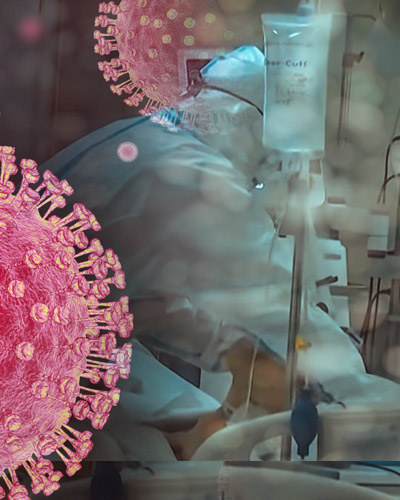October 12, 2023 | Deborah Kotz
Acinetobacter baumannii and Candida auris identified in significant percentage of patients receiving mechanical ventilation in Maryland.
University of Maryland School of Medicine (UMSOM) researchers conducted a statewide survey of all patients on breathing machines in hospitals and long-term care facilities and found that a significant percentage of them harbored two pathogens known to be life-threatening in those with compromised immune systems. One pathogen, Acinetobacter baumannii, was identified in nearly 31 percent of all patients on ventilators to assist with their breathing; Candida auris was identified in nearly 7 percent of patients on ventilators, according to the study which was published this week in the Journal of the American Medical Association.

“We found patients in long-term care facilities, like skilled nursing homes, were more likely to be colonized with these pathogens than those getting treated in hospitals,” said study leader Anthony Harris, MD, MPH, Professor of Epidemiology & Public Health at UMSOM and infectious disease specialist at University of Maryland Medical Center. “We were the first in the nation to get a statewide survey of all ventilated patients, and I think it points to the stringency of the infection control programs in place in the state of Maryland and the excellent collaboration between the University of Maryland and the State Health Department.”
Both A. baumannii and C. auris have been highlighted by the federal Centers for Disease Control and Prevention (CDC) as emerging pathogens that present a global health threat. C. auris is a fungus that spreads within and among local healthcare facilities--usually in those hospitalized and on breathing machines (ventilators). Older people with weakened immune systems are particularly susceptible to this infection, which resists treatment with common anti-fungal medications. A. baumannii, a bacteria, also poses a threat to these same types of patients and has become very resistant through the years to treatment with most antibiotics.

“Testing positive, however, does not mean that patients have symptoms or active infections that are potentially life-threatening,” said study co-author J. Kristie Johnson, PhD, Professor of Pathology at UMSOM whose lab did the A. baumannii testing for the study. “But knowing which patients are colonized with these pathogens can help contain their spread to other patients.”
Over the course of 2022, state and local health departments around the country reported 2,377 clinical cases, according to the CDC, nearly five times the number infections in 2019, which was less than 500 cases. Maryland alone had 46 cases in 2022. While these infections don’t normally pose much of health risk to hospital workers, they pose a significant risk of death in patients with weakened immune systems. Often the infections can be spread from patient to patient by health care workers carrying the germs on their hands, equipment or clothing.

“Emerging pathogens that are resistant to available therapeutics present a growing challenge in our country, especially with a projected increased growth in our aging population entering long term care facilities,” said UMSOM Dean Mark Gladwin, MD, who is also Executive Vice President for Medical Affairs, UM Baltimore, and the John Z. and Akiko K. Bowers Distinguished Professor at UMSOM. “Nearly half of patients who contract C. auris infections die within 90 days, according to the CDC, and this pathogen is now found in nearly 50 states. This is why it is critical for these surveillance studies to be conducted nationwide, not just in Maryland.”
UMSOM faculty members Lisa Pineles, MA, Lyndsay O’Hara, PhD, Leigh Smith, MD, and Indira French, MS, were co-authors on this study. The study was funded by a grant from the CDC (1U54CK000450-01).
About the University of Maryland School of Medicine
Now in its third century, the University of Maryland School of Medicine was chartered in 1807 as the first public medical school in the United States. It continues today as one of the fastest growing, top-tier biomedical research enterprises in the world -- with 46 academic departments, centers, institutes, and programs, and a faculty of more than 3,000 physicians, scientists, and allied health professionals, including members of the National Academy of Medicine and the National Academy of Sciences, and a distinguished two-time winner of the Albert E. Lasker Award in Medical Research. With an operating budget of more than $1.2 billion, the School of Medicine works closely in partnership with the University of Maryland Medical Center and Medical System to provide research-intensive, academic, and clinically based care for nearly 2 million patients each year. The School of Medicine has more than $500 million in extramural funding, with most of its academic departments highly ranked among all medical schools in the nation in research funding. As one of the seven professional schools that make up the University of Maryland, Baltimore campus, the School of Medicine has a total population of nearly 9,000 faculty and staff, including 2,500 students, trainees, residents, and fellows. The School of Medicine, which ranks as the 8th highest among public medical schools in research productivity (according to the Association of American Medical Colleges profile) is an innovator in translational medicine, with 606 active patents and 52 start-up companies. In the latest U.S. News & World Report ranking of the Best Medical Schools, published in 2023, the UM School of Medicine is ranked #10 among the 92 public medical schools in the U.S., and in the top 16 percent (#32) of all 192 public and private U.S. medical schools. The School of Medicine works locally, nationally, and globally, with research and treatment facilities in 36 countries around the world. Visit medschool.umaryland.edu
Contact
Deborah Kotz
Senior Director of Media Relations
Office of Public Affairs & Communications
University of Maryland School of Medicine
Email: DKotz@som.umaryland.edu
o: 410-706-4255
c: 410-804-0054
t: @debkotz2
Related stories

Friday, April 05, 2024
Researchers Identify New Genetic Risk Factors for Persistent HPV Infections
Human papillomavirus (HPV) is the second most common cancer-causing virus, accounting for 690,000 cervical and other cancers each year worldwide. While the immune system usually clears HPV infections, those that persist can lead to cancer, and a new finding suggests that certain women may have a genetic susceptibility for persistent or frequent HPV infections. These genetic variants, identified in a study led by University of Maryland School of Medicine researchers, could raise a woman’s risk of getting cervical cancer from a high-risk HPV infection.

Tuesday, November 01, 2022
Youngest Girls Who Get Pregnant Have Highest Risk of Poor Outcomes, Study Finds
Pregnant teens in the U.S. have long been known to face increased health risks and pregnancy complications, but a new study for the first time finds that girls ages 13 or younger who get pregnant face even greater risks. These very young girls are significantly more likely to experience preterm birth, cesarean delivery, and admission to the intensive care unit (ICU) compared to older pregnant teens. Researchers from the University of Maryland School of Medicine (UMSOM) and the University of Pennsylvania Perelman School of Medicine led the study, which was published today in the Journal of the American Medical Association (JAMA).

Tuesday, May 31, 2022
Most Doctors Still Believe in Prescribing Unnecessary Antibiotics to Treat Asymptomatic Infections, UM School of Medicine Study Suggests
An estimated 70 percent of primary care physicians reported in a survey that they would still prescribe antibiotics to treat asymptomatic infections based solely on a positive urine specimen. This is despite long-held medical guidelines recommending against this practice, according to a new study published in JAMA Network Open, which was led by University of Maryland School of Medicine (UMSOM) researchers.

Tuesday, May 11, 2021
New Study Suggests Pregnant Women Hospitalized for Covid-19 Infection Do Not Face Increased Risk of Death
Pregnant women who develop severe COVID-19 infections that require hospitalization for pneumonia and other complications may not be more likely to die from these infections than non-pregnant women. In fact, they may have significantly lower death rates than their non-pregnant counterparts. That is the finding of a new study published today in the Annals of Internal Medicine conducted by researchers at the University of Maryland School of Medicine (UMSOM).

Tuesday, March 16, 2021
New Study Finds Healthcare Settings Do Not Pose Added Risk Factor for Covid-19 Infection Spread Among U.S. Healthcare Personnel
Healthcare personnel who were infected with COVID-19 faced stronger risk factors outside of the workplace than in their hospital or healthcare settings. That is the finding of a new study published today in the Journal of the American Medical association's JAMA Network Open conducted by University of Maryland School of Medicine (UMSOM) researchers and colleagues at the Centers for Disease Control and Prevention (CDC) and three other universities.

Tuesday, December 22, 2020
Largest Study of Its Kind Identifies Which COVID-19 Patients Face the Greatest Risk of Mortality During Hospitalization
Hospitalized COVID-19 patients have a greater risk of dying if they are men or if they are obese or have complications from diabetes or hypertension, according to a new study conducted by University of Maryland School of Medicine (UMSOM) researchers. In a study published in the journal Clinical Infectious Diseases, the researchers evaluated nearly 67,000 hospitalized COVID-19 patients in 613 hospitals across the country to determine the link between certain common patient characteristics and the risk of dying from COVID-19. Their analysis found that men had a 30 percent higher risk of dying compared to women of the same age and health status. Hospitalized patients who were obese, had hypertension or poorly managed diabetes had a higher risk of dying compared to those who did not have these conditions. Those aged 20 to 39 with these conditions had the biggest difference in their risk of dying compared to their healthier peers.

Monday, August 17, 2020
UMSOM’s Department of Epidemiology and Public Health Center of Excellence in Infection Control Awarded CDC Funds for COVID-19 Research
The Department of Epidemiology and Public Health (EPH) at the University of Maryland School of Medicine was recently awarded $900,000 for COVID-19 research from the Centers for Disease Control and Prevention (CDC). The funding will be used by faculty in the Department’s Division of Genomic Epidemiology and Clinical Outcomes for research to help identify the most effective measures for COVID-19 infection control in healthcare settings.

Tuesday, January 23, 2018
Novel Gene Mutations Linked to High HDL Cholesterol and Apparent Protection from Heart Disease
Researchers at the University of Maryland School of Medicine (UMSOM) have uncovered genetic mutations that may explain why people with high levels of high-density lipoprotein (HDL) cholesterol, the “good cholesterol,” have a reduced risk of coronary heart disease.

Tuesday, January 17, 2017
Special Issue of Pathogens and Disease Highlights Innovative Research by Scientists at the University of Maryland School of Medicine in Collaboration with UM School of Dentistry
New research by scientists at the University of Maryland School of Medicine (UM SOM) and the University of Maryland School of Dentistry (UM SOD), is highlighted in a special issue of Pathogens and Disease.

